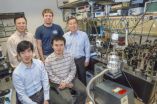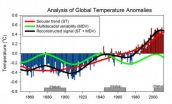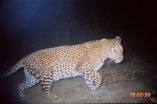(Press-News.org) A team of Berkeley Lab researchers believes it has uncovered the secret behind the unusual optoelectronic properties of single atomic layers of transition metal dichalcogenide (TMDC) materials, the two-dimensional semiconductors that hold great promise for nanoelectronic and photonic applications.
Using two-photon excitation spectroscopy, the researchers probed monolayers of tungsten disulfide, one of the most promising of 2D materials, and found evidence for the existence of excitonic dark states – energy states in which single photons can be neither absorbed nor emitted. These excitons were predicted from ab initio calculations by members of the research team to have an unusual energy sequence, plus excitonic binding energy and bandgaps that are far larger than was previously suspected for 2D TMDC materials.
"Discovery of very large excitonic binding energy and bandgaps and its nonhygrogenic nature in 2D semiconductor materials is important not only for understanding the unprecedented light-matter interaction arising from strong many-body effect, but also for electronic and optoelectronic applications, such as ultra-compact LEDs, sensors and transistors," says Xiang Zhang, director of Berkeley Lab's Materials Sciences Division and the leader of this study. "Such a large binding energy - 0.7eV - could also potentially make room-temperature excitons stable for future quantum computing efforts."
Zhang holds the Ernest S. Kuh Endowed Chair Professor at the University of California (UC) Berkeley, directs the National Science Foundation's Nano-scale Science and Engineering Center, and is a member of the Kavli Energy NanoSciences Institute at Berkeley. He and Berkeley Lab theoretical physicist Steven Louie, also with the Materials Sciences Division and UC Berkeley, are the corresponding authors of a paper in Nature that describes this research. The paper is titled "Probing excitonic dark states in single-layer tungsten disulphide." Co-authors are Ziliang Ye, Ting Cao, Kevin O'Brien, Hanyu Zhu, Xiaobo Yin, and Yuan Wang.
Excitons are bound pairs of excited electrons and holes that may cause significant deviations between photon absorption or emission energies and the electronic bandgaps that enable semiconductors to function in devices. 2D TMDC materials have generated quite a buzz in the electronics industry because they offer superior energy efficiency and carry much higher current densities than silicon. Furthermore, unlike graphene, the other highly touted 2D semiconductor, TMDCs have finite bandgaps. This makes them more device-ready than graphene, which has no natural bandgaps. However, questions marks hovering over the bandgap size and excitonic effect in 2D TMDCs have hampered their development.
"By experimentally revealing 2D excitonic dark states in a TMDC monolayer, we have demonstrated intense many-electron effects in this class of 2D semiconductors," says Ziliang Ye, a member of Zhang's research group and one of two lead authors of the Nature paper. "Our discovery provides a basis for exploiting the unusual interactions between light and matter that result from strong excitonic effects, and should also enable better designs of heterostructures that involve TMDC monolayers."
In addition to LEDs and photodetectors, the discovery of strongly bound excitonic dark states could also hold important implications for "valleytronics," a highly promising potential new route to novel electronics and ultrafast data-processing.
"In valleytronics, information is encoded in a wave quantum number that describes which valley of the energy-momentum landscape a carrier belongs to as it moves through a crystal lattice," says Louie. "Our work provides new understanding and information on the photo-excited states, and on the resulting carriers where the valley information is encoded."
Says Ting Cao, a member of Louie's research group and the other lead author of the Nature paper, "2D TMDCs should be also well-suited for the next generation of flexible devices and wearable electronics."
INFORMATION:
This work was supported by the DOE Office of Science with computer time provided by the DOE National Energy Research Scientific Computing Center.
Excitonic dark states shed light on TMDC atomic layers
Berkeley Lab discovery holds promise for nanoelectronic and photonic applications
2014-09-11
ELSE PRESS RELEASES FROM THIS DATE:
Cutting health-care costs 1 appendix at a time
2014-09-11
(SALT LAKE CITY)—Consumer price comparison is almost nonexistent in the U.S. health care system, but a new study shows that when given the choice between a less costly "open" operation or a pricier laparoscopy for their children's appendicitis, parents were almost twice as likely to choose the less expensive procedure – when they were aware of the cost difference.
The study, published in the September issue of Annals of Surgery online, shows that providing pricing information upfront can influence patient choice of surgical procedures and potentially lead to cost savings ...
Endometriosis a burden on women's lives
2014-09-11
Endometriosis often takes a long time to be diagnosed and affects all areas of a women's life, a study has found.
Research led by Monash University's Kate Young published in the Journal of Family Planning and Reproductive Health Care found that endometriosis affects women's sex lives, personal relationships, work life, and emotional wellbeing.
Endometriosis is a chronic, recurring disease that is experienced by approximately 10 per cent of women worldwide. Common symptoms include painful menstruation, heavy menstrual bleeding, painful sex and infertility.
Ms Young, ...
Perfect focus through thick layers may bring better vision to medicine
2014-09-11
WASHINGTON, Sept. 11, 2014—Zooming in on diseased tissue or scanning fragile biological samples are essential tools in medicine and biological research, but this often requires peering through layers of tissue and other materials that can blur and distort the image. Certain modern microscopes can compensate for this, but only for weak aberrations or by using invasive "guide stars," imaging aids that provide a stable reference point.
In a first-of-its-kind demonstration, published today in The Optical Society's (OSA) new high-impact journal Optica, a team of researchers ...
The ozone hole has stabilized -- some questions remain
2014-09-11
After the detection of the ozone-depleting properties of CFCs in the 1970s, data from satellite measurements in 1985 startled mankind. A huge hole had been discovered over the Antarctic in the ozone layer that protects the Earth from dangerous, carcinogenic UV rays. Already in 1987 politicians around the world reached agreement on the Montreal Protocol that bans ozone-depleting substances, in particular chlorofluorocarbons (CFCs). 197 states have now ratified this international treaty. A series of scientific expert reports has since accompanied the efforts to save the ozone ...
Crop improvement and resistance to pathogens benefits from non-coding RNA studies
2014-09-11
With the rise of emerging economies around the world and a concomitant upgrade of health care systems, the global population has been rapidly expanding. As a consequence, worldwide demand for agricultural products is also growing.
Crops now provide food and the other important resources for seven billion humans.
Food supplies are primarily based on such crops as wheat, maize, rice and vegetables. But as the area of arable land and of cultivated land continues to decline, the future ability to meet the world's food security needs has come under a cloud of uncertainty.
Meanwhile, ...
Last decade's slow-down in global warming enhanced by an unusual climate anomaly
2014-09-11
A hiatus in global warming ongoing since 2001 is due to a combination of a natural cooling phase, known as multidecadal variability (MDV) and a downturn of the secular warming trend. The exact causes of the latter, unique in the entire observational record going back to 1850, are still to be identified, according to an article by the European Commission's Joint Research Centre (JRC).
The earth hasn't warmed at the same pace during the 20th century. The noticeable temperature increases during some periods interspersed with fairly stable or decreasing levels during others ...
The quantum revolution is a step closer
2014-09-11
Theories show how computing devices that operate according to quantum mechanics can solve problems that conventional (classical) computers, including super computers, can never solve. These theories have been experimentally tested for small-scale quantum systems, but the world is waiting for the first definitive demonstration of a quantum device that beats a classical computer.
Now, researchers from the Centre for Quantum Photonics (CQP) at the University of Bristol together with collaborators from the University of Queensland (UQ) and Imperial College London have increased ...
VALUE study reports on accreditation status
2014-09-11
SEPTEMBER 2014 | Ellicott City, MD – The Intersocietal Accreditation Commission (IAC) announced today that researchers from the University of Miami Miller School of Medicine have published a manuscript in Vascular Medicine analyzing a random national sample of Medicare beneficiary data to determine the outpatient vascular testing facilities' accreditation status and geographic location. The study manuscript entitled, "Accreditation Status and Geographic Location of Outpatient Vascular Testing Facilities Among Medicare Beneficiaries: The VALUE (Vascular Accreditation, Location ...
Bully victims more likely to suffer night terrors and nightmares by age 12
2014-09-11
Children who are bullied at ages 8-10 are more likely to suffer from sleep walking, night terrors or nightmares by the time they are 12 years old.
In a study published this week in Pediatrics, journal of the American Pediatric Association, Professor Dieter Wolke and Dr Suzet Tanya Lereya from the University of Warwick, found being bullied increases the risk for a category of sleep disorders known as parasomnias. These are sleep-related problems such as nightmares, night terrors or sleep walking.
A cohort of children from the Avon Longitudinal Study of Parents and Children ...
Study: Cat bites dog
2014-09-11
NEW YORK (September 11, 2014) – A new study led by the Wildlife Conservation Society reveals that in India's human dominated agricultural landscapes, where leopards prowl at night, it's not livestock that's primarily on the menu – it is man's best friend.
The study, which looked at scat samples for leopards in India's Ahmednagar's district in Maharashtra, found that 87 percent of their diet was made up of domestic animals. Domestic dog dominated as the most common prey item at 39 percent and domestic cats were second at 15 percent.
Seventeen percent of the leopard's ...
LAST 30 PRESS RELEASES:
Numbers in our sights affect how we perceive space
SIMJ announces global collaborative book project in commemoration of its 75th anniversary
Air pollution exposure and birth weight
Obstructive sleep apnea risk and mental health conditions among older adults
How talking slows eye movements behind the wheel
The Ceramic Society of Japan’s Oxoate Ceramics Research Association launches new international book project
Heart-brain connection: international study reveals the role of the vagus nerve in keeping the heart young
Researchers identify Rb1 as a predictive biomarker for a new therapeutic strategy in some breast cancers
Survey reveals ethical gaps slowing AI adoption in pediatric surgery
Stimulant ADHD medications work differently than thought
AI overestimates how smart people are, according to HSE economists
HSE researchers create genome-wide map of quadruplexes
Scientists boost cell "powerhouses" to burn more calories
Automatic label checking: The missing step in making reliable medical AI
Low daily alcohol intake linked to 50% heightened mouth cancer risk in India
American Meteorological Society announces Rick Spinrad as 2026 President-Elect
Biomass-based carbon capture spotlighted in newly released global climate webinar recording
Illuminating invisible nano pollutants: advanced bioimaging tracks the full journey of emerging nanoscale contaminants in living systems
How does age affect recovery from spinal cord injury?
Novel AI tool offers prognosis for patients with head and neck cancer
Fathers’ microplastic exposure tied to their children’s metabolic problems
Research validates laboratory model for studying high-grade serous ovarian cancer
SIR 2026 delivers transformative breakthroughs in minimally invasive medicine to improve patient care
Stem Cell Reports most downloaded papers of 2025 highlight the breadth and impact of stem cell research
Oxford-led study estimates NHS spends around 3% of its primary and secondary care budget on the health impacts of heat and cold in England
A researcher’s long quest leads to a smart composite breakthrough
Urban wild bees act as “microbial sensors” of city health.
New study finds where you live affects recovery after a hip fracture
Forecasting the impact of fully automated vehicle adoption on US road traffic injuries
Alcohol-related hospitalizations from 2016 to 2022
[Press-News.org] Excitonic dark states shed light on TMDC atomic layersBerkeley Lab discovery holds promise for nanoelectronic and photonic applications





